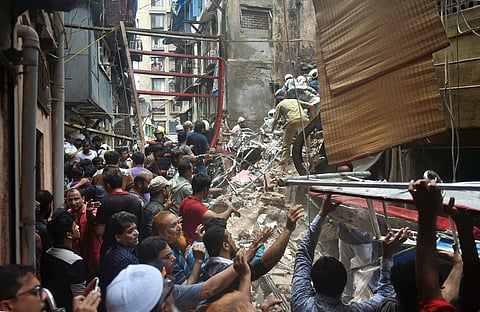

MUMBAI: The name of the ill-fated Kausar Baug Building, which crashed on Tuesday killing at least two persons, is mysteriously omitted from a comprehensive list of 499 "dangerous" buildings prepared by the BrihanMumbai Municipal Corporation (BMC), said an RTI activist.
There is no confirmation on the final toll as the rescue operations are still underway.
Mumbai Building Repairs and Reconstruction Board (MBRRB) Chairman Vinod Ghosalkar, however, feared the toll on Tuesday could be at least 12.
"The BMC, as per the directions of the Bombay High Court had compiled the list of the dilapidated buildings, which we secured through an RTI reply. Shockingly, Kesarbai Building's name is not mentioned anywhere in the list," Shakeel Ahmed Sheikh told IANS.
As per RTI replies given by the BMC, from January 2013 till the day, Mumbai has witnessed a staggering 2,704 different types of crashes including buildings, walls, balconies, slabs, portions of homes, etc.
"This has resulted in 234 deaths, including 82 women and 152 men, besides injuring another 840, comprising 302 females and 538 males. Despite these tragedies, no steps have been taken by the BMC to demolish the buildings declared 'dangerous' in the past six years," Sheikh said.
He said that way back in 2014, a Bombay High Court Division Bench comprising Justice A.V. Mohta and Justice A.A. Sayed had directed the BMC to identify all dilapidated and dangerous buildings in Mumbai and put up their list on its website.
Based on the condition of the structures, the classifications are C2 - buildings which can be repaired, and C1 - buildings which cannot be repaired and must be demolished at the earliest, he added.
The court had also ordered the BMC to draw up the list irrespective of its ownership -- whether private, government, BMC, or any other agency -- and send notices to the occupants to vacate such buildings.
"Its five years since the court orders, but the BMC has done nothing to evacuate all these 499 dangerous (C1) buildings and demolish them. Another big tragedy can happen anytime," warned Sheikh.
Following a complaint by a resident, the BMC had sent a notice to the Kesarbai Building owners, Bai Hirabai Rahimbhai Aloo Paroo and Bai Kesarbai Dharamsay Khakoo Charitable and Religious Trust, ordering them to carry out a structural audit of the structure.
On July 31, 2017, after the audit report was submitted, the building was classified as 'C1', to be evacuated immediately and demolished on priority.
However, a month later the BMC learnt that the building was actually a cessed building of Maharashtra Housing & Area Development Authority (MHADA), over which it had no jurisdiction.
Accordingly, on August 7, 2017, the BMC wrote to the Executive Engineer, Mumbai Building Repairs & Reconstruction Board (MBRRB) of MHADA, to take appropriate measures as per the high court orders (above) to prevent any loss of life.
At the same time, the BMC also washed its hands off the matter saying the civic body would not be responsible for any mishap that befalls Kesarbai Building.
Sheikh said that on July 2, through his NGO Adhikar Foundation, he had written to BMC Commissioner Praveen Pardeshi to take immediate steps to demolish the 499 "dangerous" buildings in the city.
Exactly a fortnight later, Kesarbai Building came crashing down at around 11.30 a.m. on Tuesday.